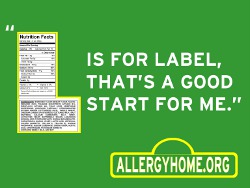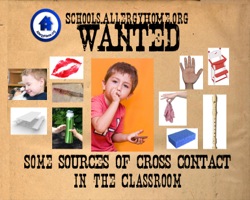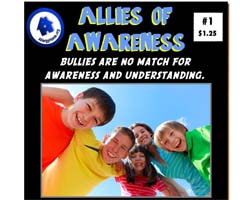
Food Allergy Awareness Week Resources 2015
1.
Morning Announcements: This is an easy way to help spread awareness in your school. Share our announcements each day of Food Allergy Awareness Week.
2.“
What is Food Allergy: Kids Awareness Module”: We encourage you to share this module with your students at some point this week. This 4 1/2 minute awareness module is designed for elementary age children without food allergies with the purpose of increasing empathy and support and discouraging bullying.
3.
Posters: We have free posters for you to download. We chose one poster for each day of our morning announcements. We hope that you will add these posters to your school bulletin board or your classroom.
4. “
School Staff Training Module”: This 30 minute module is designed to assist the school nurse in staff training of management of life-threatening allergic reactions and increase food allergy awareness for all school staff including teachers, food service personnel, administrators, aides, specialists, coaches, bus drivers, custodians and others.Topics include food allergy basics, label reading, common hidden ingredients, cross-contact, recognition of allergic reactions & anaphylaxis, how to give epinephrine, issues in specific school settings, and the social/psychological impact of food allergies.
We thank Gina Lee for her help in creating the Morning Announcements.
Food Allergy Awareness Week Morning Announcements
Download Announcements Here
Monday
Morning Announcement
May 10th-16th is Food Allergy Awareness Week. Did you know that 1 in 13 children has a food allergy? This means that almost everyone knows at least one person with a food allergy. This week we will be learning about ways we can support our classmates with food allergies. Your teacher also may share a short video about food allergies in class.
Explanation
This
4 ½ minute slide show teaches elementary school age children without food allergies why kids with food allergies need to do things a bit differently. It is designed to increase understanding, encourage children to support their classmates, and discourage bullying. This resource can be used by school nurses and teachers in the classroom as well as a tool to introduce families in the school community to the basic concepts of food allergies.
Tuesday

Morning Announcement
Label reading is key to preventing allergic reactions. Ingredient labels let people with a food allergy know whether or not a food is safe for them to eat. Remember If ‘you (or a grown up) can’t read it, then don’t eat it.’
Explanation
Label reading is the building block to avoiding food allergen. Make label reading a part of what you always do and involve kids in developmentally appropriate ways. Anyone responsible for serving food to a person with food allergy needs to be knowledgeable about the labeling laws and their pitfalls. If there is an item that does not have a label it is safest to avoid eating it. This issue often comes up with outside foods and baked items which can be a source of hidden allergens and a risk for people with food allergies. For younger ones let them know that a grown-up needs to read the label and OK what they eat. As they start reading they can practice label reading with you, and by the time they are older and may be responsible it is old hat. “If you (or a trusted grown-up) can’t read it then don’t eat it.”
Wednesday

Morning Announcement
Did you know that even tiny amounts of a food can cause an allergic reaction? You can help keep your classmates safe by washing your hands after eating.
Explanation
Cross contact is the presence of unintended food allergen. Exposure to an allergen by cross contact is a common cause of allergic reactions. Cross contact of food allergen can occur from contact with surfaces, other foods, and with transfer of saliva. If a person is then exposed to these allergens, especially by mouth, it may be enough of an exposure to cause a serious allergic reaction. Keep in mind that allergens can withstand heating and drying and exposure to small amounts of allergen is enough to result in anaphylaxis. Saliva, whether from a person or a pet can contain allergens and therefore can be a source of cross contact. For this reason sharing of anything that goes in the mouth can become a source. If students have contact with pets, keep in mind that pet food can contain allergens. Preventing cross contact with cleaning is important. Establish a cleaning protocol to avoid cross contact. Allergens can also enter the system through the eyes, and nose.
Thursday
Morning Announcement
People with food allergies need to always take good care of themselves no matter where they are or who they’re with. Support your friends with food allergies by including them at lunch, recess and outside of school. Help them stay safe and have fun too!
Explanation
Food allergies can be life threatening. People with food allergies need to always take good care of themselves no matter where they are or who they’re with. Help students support their friends and help them encourage good choices
. School-wide food allergy awareness can help create an environment of support and understanding. Direct student education may be very effective. Children also can play an important role in teaching each other, their parents, and play a critical role in establishing a supportive community.
Friday

Morning Announcement
Food Allergies are serious. If you see bullying of any kind, speak up. Bullying is never OK but when it comes to food allergy, bullying can be down right dangerous. Be an ally and take good care of each other. It’s no joke!
Explanation
While swiftly dealing with bullying is critical, stopping food allergy related bullying before it starts is an important and achievable goal. Students can pick up on the messages of their teachers, parents, and others in the school community and bullying may arise when there are misperceptions and negative attitudes about food allergies. Replacing these with education can create an
environment of support and understanding. Educating staff and parents can change the attitudes of children. Direct education to students may be very effective. Children also can play an important role in teaching each other, their parents, and play a critical role in establishing a supportive community. We can teach bystanders to be allies who support and look out for their peers.